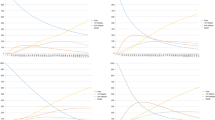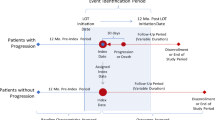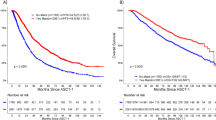Abstract
Treatment options for secondary progressive multiple sclerosis (SPMS) are limited. Mitoxantrone is routinely used to stabilize disease progression; however, evolving evidence suggests clinical benefit from intensive treatment with autologous haematopoietic stem cell transplantation (HSCT). Given differences in cost and outcomes, preliminary cost-effectiveness studies are warranted if this approach is to be developed for more widespread application in SPMS. We developed a decision-analytic Markov model to explore the potential cost-effectiveness of autologous HSCT versus mitoxantrone in SPMS, using patient-level data from registry sources. The model evaluates the lifetime costs and health outcomes associated with disability progression and relapse. Sensitivity analyses were undertaken to examine the uncertainty surrounding cost-effectiveness outcomes. In the absence of randomised controlled trial (RCT) evidence, conditions for comparative analysis were not ideal. Under optimistic assumptions, HSCT is estimated to cost below £3000 per quality adjusted life year gained. However, when a strict 6-month sustained progression rule is adopted, HSCT may be less effective and more expensive than mitoxantrone. The model results were sensitive to reducing procedural costs and HSCT-related mortality. We conclude that HSCT could potentially achieve an acceptable level of cost-effectiveness. However, caution should be exercised as large, high-quality RCTs comparing HSCT versus mitoxantrone are necessary to validate these findings.
This is a preview of subscription content, access via your institution
Access options
Subscribe to this journal
Receive 12 print issues and online access
$259.00 per year
only $21.58 per issue
Buy this article
- Purchase on Springer Link
- Instant access to full article PDF
Prices may be subject to local taxes which are calculated during checkout


Similar content being viewed by others
References
Sadovnick AD, Ebers GC, Dyment DA, Risch NJ . Evidence for genetic basis of multiple sclerosis. The Canadian collaborative study group. Lancet 1996; 347: 1728–1730.
Confavreux C, Compston A . The natural history of multiple sclerosis. In: Compston A (ed). McAlpine's Multiple Sclerosis, 4th edn. Elsevier: London, 2006, pp 183–272.
Weinshenker BG, Ebers GC . The natural history of multiple sclerosis. Can J Neurol Sci 1987; 14: 255–261.
Tyas D, Kerrigan J, Russell N, Nixon R . The distribution of the cost of multiple sclerosis in the UK: how do costs vary by illness severity? Value Health 2007; 10: 386–389.
Patwardhan MB, Matchar DB, Samsa GP, McCrory DC, Williams RG, Li TT . Cost of multiple sclerosis by level of disability: a review of literature. Mult Scler 2005; 11: 232–239.
Tappenden P, Chilcott JB, Eggington S, Oakley J, McCabe C . Methods for expected value of information analysis in complex health economic models: developments on the health economics of interferon-beta and glatiramer acetate for multiple sclerosis. Health Technol Assess 2004; 8: 1–78.
Kurtzke JF . Rating neurologic impairment in multiple sclerosis: an expanded disability status scale (EDSS). Neurology 1983; 33: 1444–1452.
National Institute for Clinical Excellence. Management of multiple sclerosis in primary and secondary care. Clinical Guideline. NICE: London, 2003.
Renoux C, Vukusic S, Mikaeloff Y, Edan G, Clanet M, Dubois B et al. Natural history of multiple sclerosis with childhood onset. N Engl J Med 2007; 356: 2603–2613.
Hughes RA, Sharrack B . More immunotherapy for multiple sclerosis. J Neurol Neurosurg Psychiatr 1996; 61: 239–241.
Hartung HP, Gonsette R, Konig N, Kwiecinski H, Guseo A, Morrissey SP et al. Mitoxantrone in progressive multiple sclerosis: a placebo-controlled, double-blind, randomised, multicentre trial. Lancet 2002; 360: 2018–2025.
US Food and Drugs Administration. Mitoxantrone scientific review. Available from: http://www.fda.gov/cder/ [Accessed 18 January 2008].
Kapoor S, Wilson AG, Sharrack B, Lobo A, Akil M, Sun L et al. Haemopoietic stem cell transplantation--an evolving treatment for severe autoimmune and inflammatory diseases in rheumatology, neurology and gastroenterology. Hematology 2007; 12: 179–191.
Saccardi R, Di Gioia M, Bosi A . Haematopoietic stem cell transplantation for autoimmune disorders. Curr Opin Hematol 2008; 15: 564–600.
European Group for Blood and Marrow Transplantation. High dose immunoablation and autologous stem cell transplantation versus mitoxantrone therapy in severe multiple sclerosis: a multicenter, prospective, randomized, phase II study. Clinical Trial Protocol 2007: 1–90. EudraCT 2007-000064-24.
Drummond MF, Sculpher MJ, Torrance GW, O'Brien BJ, Stoddart GL . Methods for the Economic Evaluation of Health Care Programmes, 3rd edn. Oxford University Press: New York, 2007: 1–90. EudraCT 2007-000064-24.
National Institute for Health and Clinical Excellence. Guide to the Methods of Technology Appraisal. NICE: London, 2008.
Confavreux C . Lyon Clinique de Neurologie MS Registry. Data Held on File 2008.
Mancardi G, Saccardi R . Autologous haematopoietic stem-cell transplantation in multiple sclerosis. Lancet Neurol 2008; 7: 626–636.
Confavreux C, Compston DA, Hommes OR, McDonald WI, Thompson AJ . EDMUS, a European database for multiple sclerosis. J Neurol Neurosurg Psychiatr 1992; 55: 671–676.
Kurtzke JF . A new scale for evaluating disability in multiple sclerosis. Neurology 1955; 5: 580–583.
Amato MP, Grimaud J, Achiti I, Bartolozzi ML, Adeleine P, Hartung HP et al. European validation of a standardized clinical description of multiple sclerosis. J Neurol 2004; 251: 1472–1480.
Saccardi R . European group for blood and marrow transplantation MS registry. Data Held on File 2008.
Carreras E, Saiz A, Marin P, Martinez C, Rovira M, Villamor N et al. CD34+ selected autologous peripheral blood stem cell transplantation for multiple sclerosis: report of the toxicity and treatment results at one year of follow-up in 15 patients. Haematologica 2003; 88: 306–314.
Saccardi R, Kozak T, Bocelli-Tyndall C, Fassas A, Kazis A, Havrdova E et al. Autologous stem cell transplantation for progressive multiple sclerosis: update of the European Group for Blood and Marrow Transplantation autoimmune diseases working party database. Mult Scler 2006; 12: 814–823.
Orme M, Kerrigan J, Tyas D, Russell N, Nixon R . The effect of disease, functional status, and relapses on the utility of people with multiple sclerosis in the UK. Value Health 2007; 10: 54–60.
Department of Health. NHS Reference Costs 2006–2007. Available from http://www.dh.gov.uk/ [Accessed 24 March 2008].
British Medical Association. British National Formulary No. 55. Available from: http://www.bnf.org/bnf/ [Accessed 24 March 2008].
Biogen Idec. Natalizumab (Tysabri) for the treatment of adults with highly active relapsing remitting multiple sclerosis. In: Kerrigan J (ed). Submission to the National Institute for Health and Clinical Excellence. NICE: London, 2007, pp 1–269.
Tappenden P, Chilcott JB, O'Hagan A, McCabe C, Cooper NJ, Abrams KA et al. Cost-effectiveness of beta interferon and glatiramer acetate in the management of multiple sclerosis. Report to the National Institute for Clinical Excellence. NICE: London, 2001.
Chilcott J, McCabe C, Tappenden P, O'Hagan A, Cooper NJ, Abrams K et al. Modelling the cost effectiveness of interferon beta and glatiramer acetate in the management of multiple sclerosis. Br Med J 2003; 326: 522–528.
Acknowledgements
This study was undertaken without commercial or research funding.
Author information
Authors and Affiliations
Corresponding author
Ethics declarations
Competing interests
The authors declare no conflict of interest.
Rights and permissions
About this article
Cite this article
Tappenden, P., Saccardi, R., Confavreux, C. et al. Autologous haematopoietic stem cell transplantation for secondary progressive multiple sclerosis: an exploratory cost-effectiveness analysis. Bone Marrow Transplant 45, 1014–1021 (2010). https://doi.org/10.1038/bmt.2009.305
Received:
Revised:
Accepted:
Published:
Issue Date:
DOI: https://doi.org/10.1038/bmt.2009.305
Keywords
This article is cited by
-
Stammzelltransplantation bei Multipler Sklerose - wo stehen wir?
InFo Neurologie + Psychiatrie (2022)
-
Evaluating the clinical effectiveness of autologous haematopoietic stem cell transplantation versus disease-modifying therapy in multiple sclerosis using a matching-adjusted indirect comparison: an exploratory study from the Autoimmune Diseases Working Party (ADWP) of the European Society of Bone and Marrow Transplantation (EBMT)
Bone Marrow Transplantation (2020)
-
Autologous haematopoietic stem cell transplantation and other cellular therapy in multiple sclerosis and immune-mediated neurological diseases: updated guidelines and recommendations from the EBMT Autoimmune Diseases Working Party (ADWP) and the Joint Accreditation Committee of EBMT and ISCT (JACIE)
Bone Marrow Transplantation (2020)
-
Outcomes and Cost-Effectiveness of Autologous Hematopoietic Cell Transplant for Multiple Sclerosis
Current Treatment Options in Neurology (2019)
-
Autologous haematopoietic stem cell transplantation for treatment of multiple sclerosis
Nature Reviews Neurology (2017)



